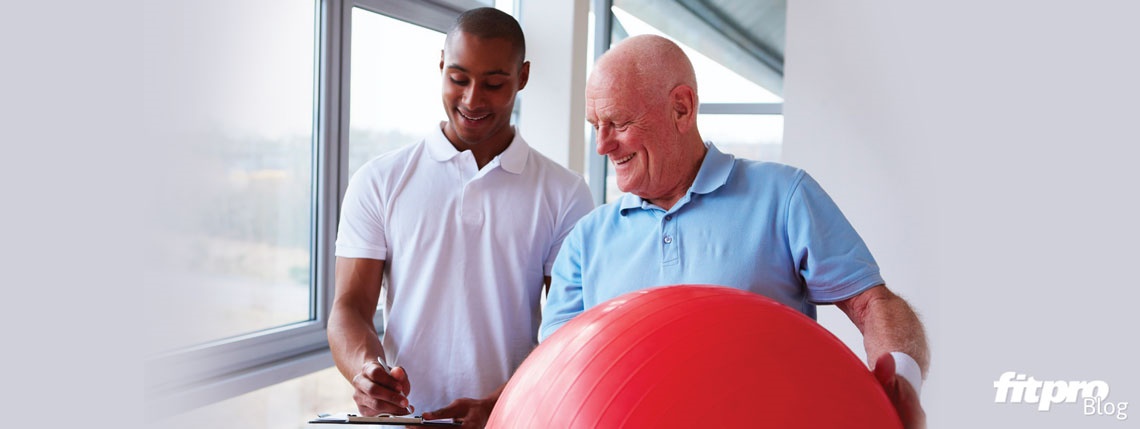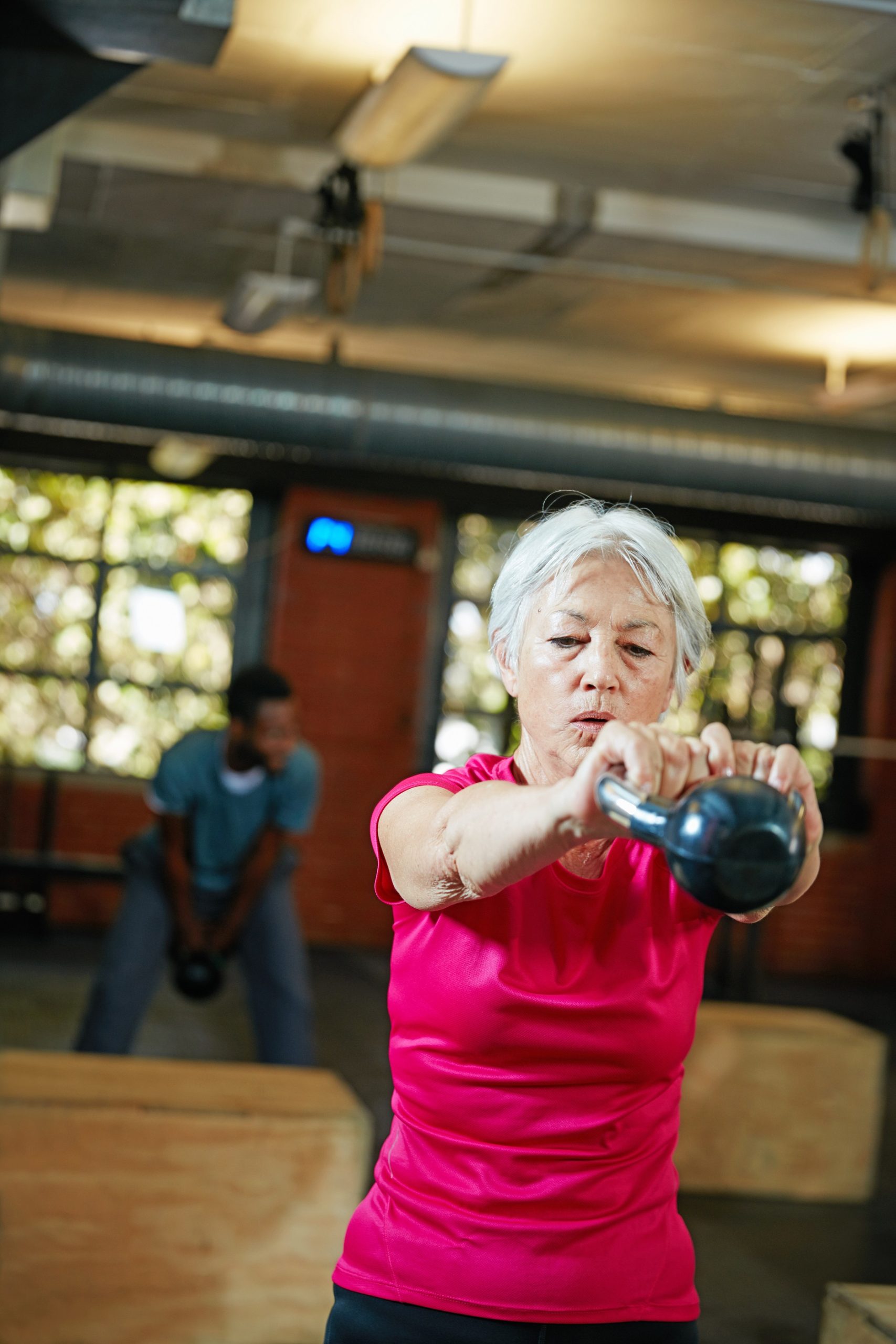When it comes to mature clients, we should focus on their functional movement capabilities and not just their age, as Aislinn Kelly finds out.
Julia Willmott, whose small Pilates classes incorporate clients from the age of 40 to 70, believes instructors and PTs should look beyond the age of their clients. She says, “Find out their health and fitness background, motivation and what they need from you and they’ll stay with you forever.
Make them feel valued and remember that every individual is different. This investment will ensure your older participant gets the most out of your sessions and, in return, they’ll be your most loyal client.” Cody Sipe, co-founder of the Functional Aging Institute (which will present functional ageing workshops in the UK this June and July in collaboration with FitPro), also sees biological age as a poor indicator of a person’s physical ability as “you’ll get the competing 80 year old who can kick the butt of the 50 year old who can barely walk”. Sipe’s message is to cut out your ‘65+ class’ and ‘seniors class’ and, instead, to group clients according to their functional level.
The Hierarchy of Physical Function
At the Functional Aging Institute (functionalaginginstitute.com), Sipe works off the Hierarchy of Physical Function model, which starts with the most physically and functionally capable elite older athlete, followed by the fit, then the independent, then the frail and, finally, the dependent. Sipe explains, “The dependent group needs more intensive medical care and rehabilitation, so most of the people you’ll see are in the independent category.” According to Sipe, the issue with classification comes when you mix clients who are at the lower end of independent and starting to become frail with those who are fitter, because the frailer person needs more attention. If you’re unable to monitor the frailer clients closely, injury is possible. Or they may decide they can’t keep up and simply stop attending. “I suggest,” advises Sipe, “that you create classes with these functional capabilities in mind but be careful how you label them. The name doesn’t need to indicate this class is for frail people, for instance, as the description of the intensity and the class purpose will indicate who it’s for.”
The boomers – the oldest of whom are turning 70 this year – don’t necessarily consider themselves as ‘ageing’. Sipe finds they view themselves as much younger than their biological age, so a 70 year old would most likely reject a 70+ class as ‘too old’ for them. Willmott sums it up: “With older clientele, it’s not just about how old they are. It’s also about how functionally fit they are!”
Programming for the frailer classes
Those who are less independent – or on the frail side – still need to give some effort to progress. But, relatively, the intensity will be lower and the mix of what you include will be different. Although clients may think ‘fall prevention’ is for ‘old people’ (perhaps think about the language you use), the frail independent group has a greater need for static and dynamic balance training.
With clients rehabilitating after a fall, Willmott liaises with their physio or consultant to provide a one-to-one programme. This helps the client recover and gives them confidence to return to movement and exercise. “Some clients have suffered from shoulder dislocations, having put their hand out when falling, and it’s noticeable that those who stick at a personalised programme develop a good range of movement and strengthen the muscles around the joint, increasing functional ability and helping to prevent further issues. Pilates also helps them to become steadier on their feet as their proprioception (the ability to know where their limbs are without having to look) helps with balance. Building up strength in the stabilising muscles is also valuable to help people right themselves when they slip.”
Being mindful of arthritis
Arthritis is one of the most common conditions in the older population. Sipe says, “I find there are two ways people with arthritis respond. For some, it’s worse with depth so, with a squat or a lunge, the more range of motion they have in their knees, the more it hurts. With others, it’s more load sensitive.” Instructors should have one-to-one conversations with each client before they attend a class to ascertain who has arthritis in their knees, hips or spine. You should then offer personalised suggestions of how to adapt certain movements and explain why. Taking time to know who is coming to class helps you create a safe, effective programme and helps clients to feel comfortable.
To modify or not to modify?
Sipe is reluctant to use the word ‘modification’, as it implies the client can’t do a movement the right way, so you are making it easier for them. Instead, he believes in looking at the client’s functional ability to determine what they should be doing in class. “If a client can’t jump over a box, the modification might simply be standing up straight. If you’re at the point where just standing up is what’s appropriate, then it’s not a modification. It’s purposefully what you need to do. It’s a matter of scaling it up or down, depending on the individual’s capabilities.” There are lots of variables you can use to scale up or down: the load, speed, distance, depth and complexity. Sipe adds, “This is why it’s so important not to have individuals who are really disparate in functional ability in the same class because it becomes hard to juggle. In some clubs, they haven’t worked out how to segregate the groups – or they have an equipment-centred class and anyone can show up – so the ability levels are widely different. Whenever possible, grouping according to ability makes your job easier. Instead of lots of big adjustments, you’re just making little tweaks.”
Shifting values
As clients age, their goals may shift; most are exercising to stay mobile, rather than for aesthetic reasons. Willmott includes a lot of functional work – reaching, pulling, lifting, etc. – with these clients. “They love it when they can touch their toes again, turn their head fully in the car or reach a high shelf. It’s the mature client’s goal to be self-sufficient – they don’t want to rely on anyone else.” While motivations may change, it’s important not to employ age stereotypes. “Older adults who are capable are very bothered when you assume they’re incapable,” says Sipe. “At the same time, you don’t want to say that, just because someone is 80, they can’t do anything they want to do. There has to be some discretion – especially if they have medical conditions.”
Functional Ageing specialist workshop
The workshop will benefit certified small group and one-to-one personal trainers; group exercise instructors; physical therapists; physical therapy assistants; boot camp leaders.
Course content
- The importance of functional longevity
- Brief review of the applied physiology of ageing
- Functional Ageing Training Model
- Health and fitness assessment protocols
- Functionally integrated strategies and techniques
- Functionally integrated programme design
- Case studies
Dates
Saturday 20 May 2017 Glasgow
Saturday 17 June 2017 London
In this workshop, you can learn innovative exercise strategies, techniques and movements for clients over the age of 50 that have been shown to be critical to functional ageing. Through lecture and hands-on learning you will develop the knowledge and skills to perform functional fitness assessments and create functional exercise programmes for older clients. Book your place today: http://fitpro.com/workshops/bookingsystem/index.cfm?fuseaction=generalbookingshop.&category=363








